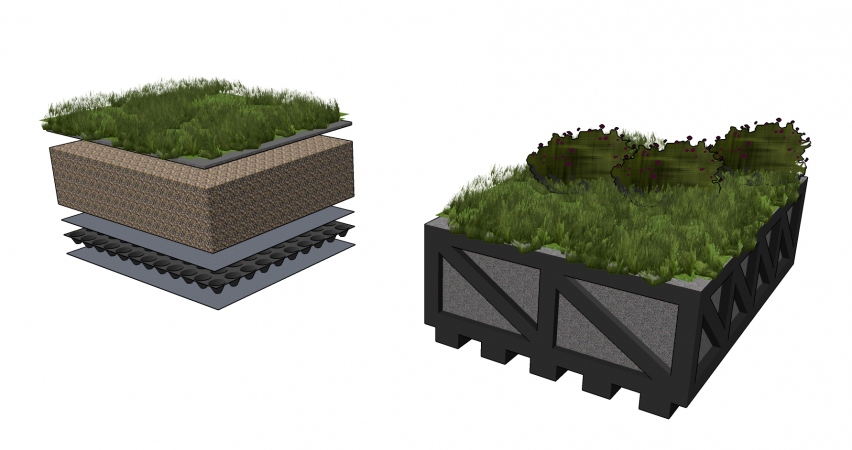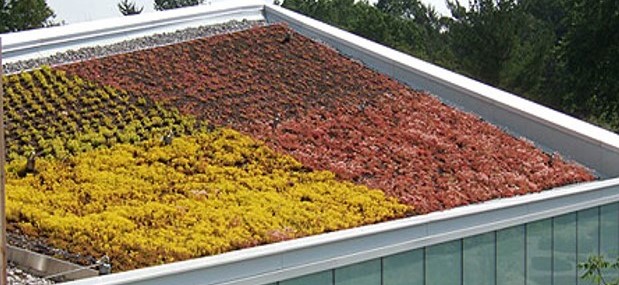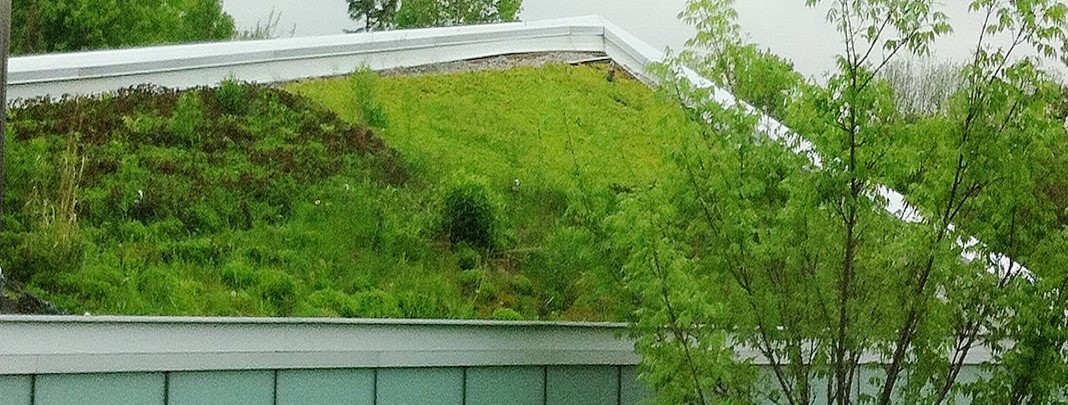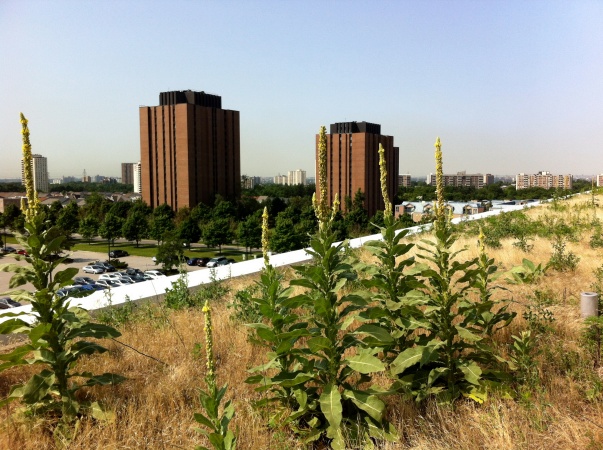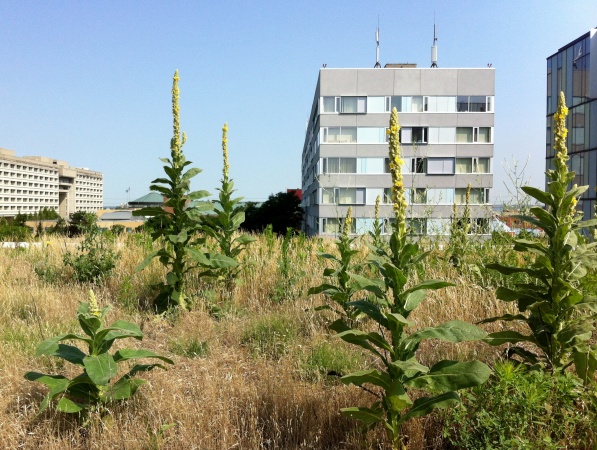Green roofs
Overview[edit]
Modern green roofs are a rapidly developing commercial market in Ontario. Their primary benefit as a LID technology is in maximizing evapotranspiration for water balance targets.
Green roofs are ideal for:
- Sites without significant space at ground level for infiltration,
- Zero-lot line projects with outdoor amenity requirements,
- Projects looking for accreditation with LEED v.4
<textsuccess>The fundamental components of a green roof are:</textsuccess>
- a roof able to withstand the load,
- a drainage layer,
- a filter layer,
- a layer of planting medium,
- plants.
<textsuccess>Additional components may include:</textsuccess>
- an irrigation system,
- pre-formed tray modules.
<panelSuccess>
</panelSuccess>
Planning Considerations[edit]
Green roofs offer a variety of co-benefits beyond stormwater management. In urban centers they are often constructed to accommodate a roof terrace or amenity space. In this scenario the stormwater capture benefit is restricted to the areas with vegetation planted. Another increasingly popular use for rooftop space is in urban farming. Again the stormwater capture benefit is restricted to the areas with planters.
To maximize the utility of a green roof as a low impact development tool, coverage with planting should be maximized. In many cases this means only inaccessible spaces are used. Within the scope of green roof coverage, there is a further distinction made between 'intensive' systems over 15 cm deep, and the more commonly employed 'extensive' systems, which are 10-15 cm deep. Specialized, shallow systems exist but their application is limited.
Amenity
Roof gardens with a high proportion of impermeable surface are popular in high rise developments. These amenity terraces are often described as green roofs, but the LID benefit applies only to the vegetated areas. The stormwater benefit of all kinds of green roofs is maximized by combined with rainwater harvesting for subsequent irrigation. Sedum and native species have all been shown to thrive with daily irrigation to saturation[1].
Rooftop farming is also becoming common in some Ontario cities. Again consideration should be given to the proportion of the roof actually planted. Where large open expanses of roof are being cropped, measures may be required to reduce erosion of exposed planting medium. Any digging or furrows will reduce the stormwater benefit.
Biodiversity
Biodiversity opportunities are optimized by planting a variety of species. General advice on this has been prepared by the City of Toronto[2]. In the long term, the richness of species increases owing to 'volunteer species'. The desirability of this diversity varies with the aesthetic concerns of the green roof owner.
<panelInfo>
</panelInfo>
Design[edit]
Planting Medium
In many proprietary systems the default option for planting medium will be a granular material with very low organic matter content. However, many companies can arrange for a high organic content alternative to be substituted if requested.
The benefits of 'high organic' media are:
- Increased water holding capacity, which benefits both vegetation health and stormwater retention,
- Often lighter weight, even when saturated,
The disadvantages of a 'high organic' planting medium are:
- Increased phosphorous concentration in runoff water, however this may be mitigated by the reduced runoff volume resulting in a lower loading overall,
- The lightweight material is more prone to wind erosion, and this should be accounted for in the initial design, alternatives include erosion control blankets, soil tackifiers, or Sedum mats.
Irrigation
Regular irrigation has been shown to substantially reduce the stormwater capture benefit of an extensive green roof[3]. However, due to their limited water retention capacity many green roofs are coupled with a cistern to capture the excess water. It then becomes desirable to use as much harvested water to regain the cistern capacity, Green roofs can be irrigated to saturation daily throughout the growing season without damaging the vegetation.
PlantingThe choice of vegetation on an extensive green roof is insignificant in stormwater management compared to the choice of planting medium or the provision of irrigation. The vegetation should be selected to be resilient to both very wet and very dry periods. Sedum species are the most common choice, demonstrating excellent longevity in systems without irrigation. However, some projects expect the low growing Sedum to remain in graphic designs according to species and flower color. This is not a realistic expectation without huge maintenance costs. Instead project stakeholders should be prepared early in the design process to embrace the green roof as a living and evolving ecosystem. <panelSuccess> </panelSuccess> Performance[edit]Water Quantity
Water QualityMany green roofs receive only rainwater, which is relatively clean when it lands. As such green roofs can contribute contamination, most notably in nutrient leaching during early establishment. But, in dense urban centres, green roofs are increasingly being used to receive irrigation from harvested rainwater. Current Ontario Building Code permits the use of rooftop runoff to be reused in this manner, so long as it is 'free of solids'. Where rainwater is harvested and reused to irrigate a green roof, there is no significant discharge of stormwater from the system, and no loading of contaminants downstream. GALLERY IN HERE Incentives and Credits[edit]In OntarioCity of Toronto updated their 'Eco roof' incentive program in 2017 . It now includes grants for structural assessment and is available to non-profit organisations [4]. LEED BD + C v.4SITES v.2See Also[edit]External Links[edit]Proprietary SystemsLinks are provided for information only. Inclusion of a company or product does not constitute endorsement.
|
